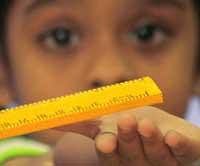
In the suicide of

13-year-old Rouvanjit Rawla of La Martiniere School in Kolkata, the insensitive, inhuman and tortuous face of our education system has been laid bare yet again. Although several psycho-social factors certainly have contributed to such an unfortunate act by the young bubbly child, caning by the school principal is largely seen as the precipitating antecedent. While the incident itself was disturbing and heart wrenching, what was more distressing was the debates and discussions that followed.
The frenzy of the TV channels that organised panel discussions, interviewed experts, brought reactions from parents, teachers and principals on whether corporal punishments in schools should be allowed or not, expectedly had a spill-over effect in our homes, schools and even streets; people as usual remained divided over whether to “to spare the rod and spoil the child” or treat the child with basic human dignity.
These deliberations were unwarranted, absolutely insensitive and annoying to say the least. The question no more deserves to be debated: We must accept the fact that children cannot be subjected to corporal punishment, whatever may the reasons be. The 1989 UN Convention on Right of Children enshrines a number of rights including protection from any kind of abuse, to which Government of India became a signatory in 1992.
There is a simple dictum: Children behave as well as they are treated.
There have been concerted efforts from several well meaning bodies to create awareness among teachers, parents and students regarding children’s rights. Based on the UN convention, social studies textbook of VIII standard published by NCERT explains article 28 as “I have the right to make mistakes and everyone has the responsibility to accept we can learn from our mistakes.”
In further elaboration, it says “I have the right to live without violence and corporal punishment (verbal, physical, emotional) and everyone has the responsibility not to be violent to others (article 2, 28, 37 & 39).” In December 2000, the supreme court had banned corporal punishment directing that, “children receive education in an environment of freedom and dignity, free from fear.”
A few years later in August 2007, the National Commission for Protection of Child Rights (NCPCR) had written to chief secretaries of all states to ban corporal punishments in schools, since “it is a breach of fundamental human rights.” The onus clearly is on the adults — parents and teachers — to ensure abuse-free ambience that is conducive for children to grow into healthy adults.
All these strictures have come about as a result of wide spread discussions, expert opinions and research findings the world over on the detrimental effects of physical punishments on children. There are conclusive evidences to show that such treatments of children rob them of their self-image, confidence, emotional health and of course, the essential joy of learning.
It instills hostility and rage without reducing the undesired behaviour. Campus violence, peer fights, ragging are but emulation of such violence. Today’s all round aggression can perhaps be traced to the childhood experiences of the perpetrators.
Archaic methodology
While education is being increasingly overhauled with changes being brought about in syllabi, examination patterns, student assessment, criteria for teacher recruitment and performance, obstinacy with which our education system retains its archaic teaching methodology and mindset towards student behaviour and discipline is regrettable.
If such regressive disciplinary methods are used in an elite school like La Martiniere, god save the children in all the modest schools scattered around the country, where a large chunk of the millions of school goers find themselves in.
In the name of instilling a sense of wrong and right among its wards and maintaining order, excesses happen in most schools, with various forms of punishments being commonplace. Notwithstanding the legal sanction against it there seems to be a covert sanction to corporal punishments in schools. The principal of the school in fact brazenly admitted to caning before the full glare of the media, as though schools know no other way of correcting children.
Parents on their part often inadvertently maintain a conspiracy of silence, fearing to protest or intervene which is construed as approval. Worse still, many in their naiveté believe that such means will bring greater good to their children.
It is certainly not easy to deal with energetic, unruly bunch of children; teachers have a harrowing time to control, channelise and then proceed to teach them. Such time calls for disciplining children, but resorting to corporal punishment is taking an easy, short route, that too without attaining the desired result.
Instead, various non-violent means of correcting behaviour can be adopted. Short periods of isolation, reasoning and explaining, bargaining, delaying gratifications as well as positive strokes like rewarding, praising, giving responsibility are more effective and long lasting. Along with training in child psychology, teachers need to be patient, understanding and above all humane.
One wonders whether there ever will be times when children will go happily, eagerly, fearlessly to the temples of learning, when slow learning will not be misconstrued as obstinacy, when curiosity will be seen as a precursor to better learning.
(The writer is an educationist)